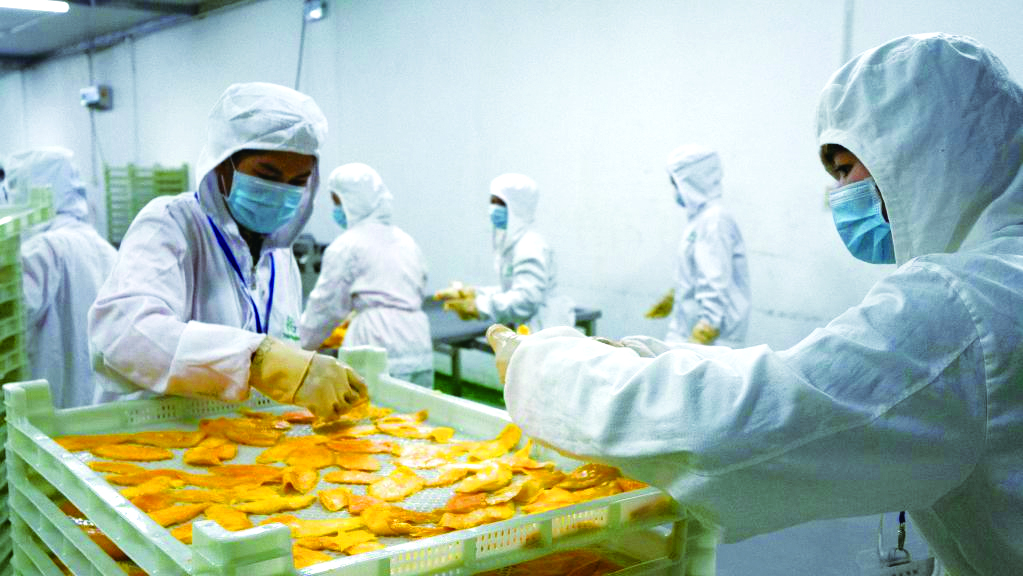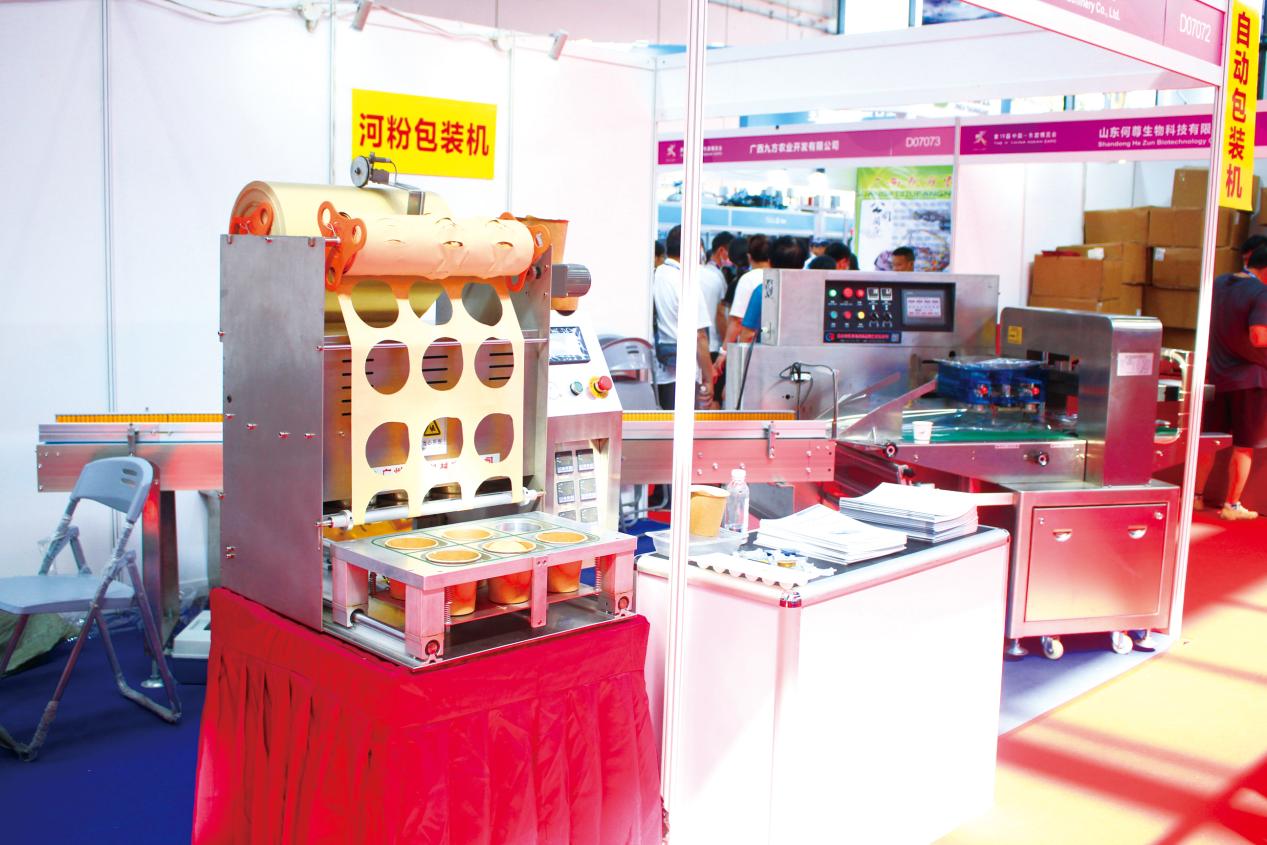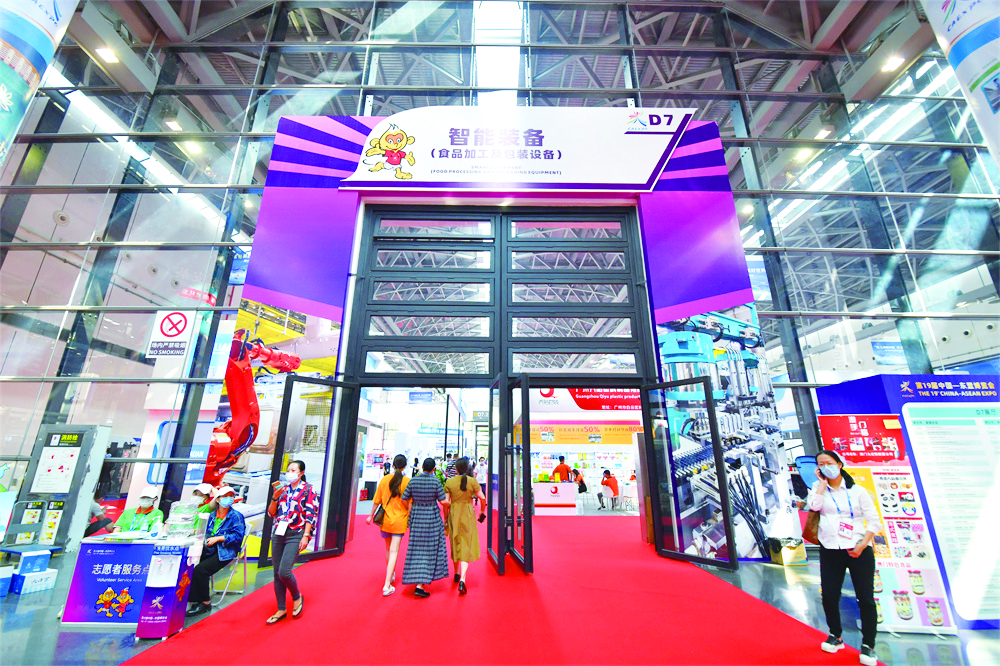

Written by Zhao Yali / Translated by Xie Zongming
For the featured food from ASEAN countries, such as the dried jackfruit from Vietnam, crusty durian cakes from Malaysia, dried mangoes from Thailand, and shrimp-flavored cracker from Brunei, food packaging and related machines play an irreplaceable role in processing the raw materials into products on the shelf, and food packaging industry is one of the key industries of China-ASEAN cooperation.
The China-ASEAN Expo (CAEXPO) has been the channel for Chinese food packaging companies to explore the ASEAN market. Every year, CAEXPO will set an exhibition for food packaging and packaging machinery (Packaging Exhibition). It provides a platform for communication and cooperation in the food packaging industry between China and ASEAN countries and allows China and ASEAN to make efforts in improving processing and packaging, which wins the applause of the food packaging companies from both sides.
Being highly complementary, made-in-China products are favored by ASEAN
Most ASEAN countries are dominated by agriculture, with abundant resources and rich varieties. With the skyrocketed agricultural and food export, expanding snacks market, and rapidly developing take away industry, ASEAN countries have started to switch their food industry from primary-processing-oriented to deep-processing-oriented, thus having an increasing demand for improving food processing technology and package quality. ASEAN countries like Thailand, Vietnam, Indonesia, Cambodia, and Myanmar have listed the development of the food industry as one of the key areas of future economic development.

For example, H.E. Miss Wantana Tatan, MinisterCounsellor of the Economy and Investment Promotion Office of the Thai Embassy in China, said that Thailand has about 9,000 food processing companies, making Thailand the main producer and exporter of processed food like canned tuna, frozen seafood, shrimp, and chicken. The Thai government has listed the food industry as one of the economic drives in the Thailand 4.0 policy.
One must notice that the food processing sector in most ASEAN countries faces the challenges of the undeveloped industry, small scale, and a capacity lower than market demands. Hence, their demands for imported package materials and equipment grow correspondingly each year. Such a demand becomes even more urgent in the face of the prosperously growing e-commerce and the entry into force of RCEP.
In fact, China's food processing industry and packing equipment manufacturing are highly complementary to ASEAN's food processing industry, boasting a huge market potential.
The advantage of China in the area outweighs that of the developed countries in Europe and North America from a cost-effective perspective. As the China-ASEAN Free Trade Area develops, tariffs on machinery will see a significant drop, and food packaging companies of China will enjoy the zero tariff policy that greatly reduces export costs, by which the products can compete with those of other countries. Plus, ASEAN, being geographically close to China, enjoys a short delivery time and ensured after-sale services when importing food packages from China.
Compared to ASEAN countries, China also has advantages in technology. The food packaging companies in China often come on a large scale with high R&D capacity and adopt more intelligent and digital technologies than ASEAN, allowing them to reduce labor costs through automatic packaging technology. Hence, cost effective Chinese food packages meet the needs of the markets of ASEAN countries, attracting considerable orders.

Currently, the food processing and packaging equipment ASEAN countries mainly import from China is the machinery for beverage processing, food shredding and mixing, and vacuum packaging, from which one can see the importance of Chinese machinery for ASEAN agricultural and food products in the intermediate process between producing and selling. The accelerated deep processing industry upgrade in ASEAN also provides huge opportunities for Chinese food processing and packaging machinery to enter its market.
CAEXPO is significant for exploring opportunities in ASEAN
In every year's CAEXPO, there is an “unspectacular” exhibition that contains enormous opportunities — the Packaging Exhibition. At the Exhibition, companies from China and ASEAN countries specialized in food processing and packaging machinery gather to show their unique products, such as adorable packages for pet food, magnificent rice planting machines, and smart automatic packaging machines. It builds a bridge for food packaging cooperation while offering purchasers from China, ASEAN, and other parts of the world a feast for the eyes.

The Packaging Exhibition of the 16th CAEXPO set 190 booths, attracting 97 companies, 26% of which are well-known in the industry, from China and ASEAN countries to participate, marking a 51% repeated participation rate. Many renowned enterprises successfully marched into the ASEAN and world market through the platform of CAEXPO and the Exhibition and spoke highly of them.
Mr. Toch, a Cambodian businessman, is a frequenter of CAEXPO. Once his Phase I factory was built, he soon came to CAEXPO for food packaging equipment procurement. At the 16th CAEXPO, he came to the Exhibition again to seek the right equipment for its expanded factory. “To me, the sense of responsibility
shown by the Chinese suppliers makes them reliable,” said Toch.
At the Promotion Meeting of Food Processing and Intelligent Packaging Machinery and Equipment of the 18th CAEXPO, 77 purchasers from countries like China, Vietnam, and Myanmar attended the Meeting for one-to-one matching. Sixty-three enterprises successfully matched up, contributing a 10-million-yuan contract value and a 20-million-yuan intended turnover. Among them, the Fuzhou Jinxiang Food Machinery Equipment and Technology Co., Ltd. of the Fujian group have participated in CAEXPO for four consecutive years. The company attracts domestic and overseas purchasers for its various cost-effective small food processing and packaging machines. Zhu Tingting, the spokesperson of the company, said, “On the first day of the Exhibition, purchasers from Thailand, Brunei, and Vietnam already showed great interest in our products. Domestic buyers from Guangdong and Guangxi also came for more information. All of these lead to an intended turnover of over 1 million yuan.”
Dabaco Group, a leading food firm in Vietnam, is one of the “big winners” at CAEXPO. “Food packaging machines bought from China are robust and stable. They make production easier and save us a lot of money,” said the participant from the company, who thought that there were various food packaging products exhibited at CAEXPO, offering more choices for the buyers, and that the caring and customized services make the Vietnamese companies satisfied.
On January 1, 2022, RCEP entered into force. ASEAN countries enjoy lower import costs as import tariffs drop, bringing new opportunities for China’s food packaging equipment to export to ASEAN countries and showing great prospects for cooperation. The 19th CAEXPO also exhibited food processing and packaging products, general machinery, and packing materials that meet the demand of the ASEAN market. Well-known companies in the industry, such as Jinda Technology, WES Machinery, Renqiu Dongwang Machinery, and HGTECH, participated in the Exhibition, which help companies to seize the opportunities.
Food packaging cooperation sees more opportunities for upgrade and development
Based on facilitating the improvement in the quality and effect of China-ASEAN economic and trade cooperation, the function of CAEXPO is extending from serving China and ASEAN countries to serving RCEP countries. In the future, CAEXPO will release more and bigger market opportunities. With various benefits brought by the implementation of RCEP, in what areas can Chinese food packaging companies strengthen cooperation with ASEAN?
On the one hand, the food packaging industry is upgrading amid the IoT age, gradually adopting digital, information, and intelligent technology. Smart manufacturing patterns based on digitalization will be a new highlight of China-ASEAN cooperation.
Therefore, the enhancement in intelligentization design like unmanned packaging and intelligent systems, the increase in technological innovation, and the improvement in packaging equipment arrangement are optimal for Chinese food packaging companies to meet the needs of downstream industries, showing the strengths of Chinese packaging products and further expanding the markets of ASEAN and other RCEP countries.
In addition, according to Ma Jianlei, Deputy Division Director of the Division of Regional Trade Affairs, Agricultural Trade Promotion Center, Ministry of Agriculture and Rural Affairs, PRC, China food packaging companies can utilize the commitments of RCEP about agricultural services investment to gain greater access to the ASEAN market and carry out cooperation in food technology and related equipment. Also, the companies can rearrange the allocation of their resources in the RCEP region, by which they can make full use of the low labor costs and agricultural resources in ASEAN and the developed food processing technology of China to carry out cross-border food industrial chain cooperation and jointly develop the RCEP market, fostering new advantages for the participation in international competition and cooperation.
On the other hand, similar to the saying that goes “Clothes make the man,” food package designs make extra attractiveness for the products at a time that values appearance like today. Creating a common language for China-ASEAN industrial
design is an attempt Liuzhou, Guangxi, makes to attract more consumers. The China-ASEAN Industrial Design and Innovation For u m and the Golden Bauhinia Cup of the China-ASEAN Industrial Design Competition, being held in Liuzhou for four consecutive years, provide a mutually-beneficial platform for promoting the in-depth integration of design, industry, technology, and culture between China and ASEAN. This year, the Competition is themed “New Free Trade, New Design, New Future”, aiming to further expand cooperation and communication between China and RCEP countries in industrial design and keep increasing the influence of events for China-ASEAN industrial design. For food packaging companies, it might be a faster way to enter the ASEAN market, with which they can reach long-term cooperation with ASEAN in package design and food processing.
桂ICP备14000177号 Copyright@2006-2013 Guangxi China-ASEAN Panorama Magazine Agency Co., Ltd. All Rights Reserved